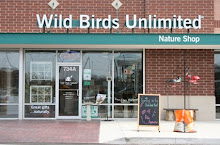Research indicates that birds are sensitive to changes in air pressure. So when the pressure drops significantly, indicating a large storm is on the way, birds take notice. If birds detect an approaching storm in the fall, when they don't have a nest or babies to protect, they will, for the most part, huddle down in dense shrubs or trees where they will be sheltered. Larger birds may attempt to fly ahead of the storm, carried by the winds at the forefront of the system. Woodpeckers and other cavity nesters have been known to use tree cavities to ride out the storm, which can be dangerous given the chance of the trees snapping or getting uprooted.
Luckily for perching birds, their feet work differently than human hands. When perching birds sit, a tendon on the backside of the ankle automatically flexes locking their toes around the branch. As the bird stands up its feet release. This holds them in place during high winds or when they sleep.
Migrating birds will avoid these storms as much as possible. However, birds can get caught up in the eye of the storm and end up hundreds of miles from where they started. This can be especially dangerous to birds that live near the ocean and can not find a food source after being displaced.
Birds can also be affected in high winds when their food supplies, such as fruits, berries, nuts and seeds are stripped from trees, shrubs and weeds. Hummingbirds can be devasted by this at the end of summer if nectaring plants are permanently damaged due to winds.
After using up a lot of energy trying to ride the storm out birds need to reload immediately after a storm. What can we do to help them? Be sure your feeders are full immediately after the storm. Feed them high protein foods, such as suet, black oil sunflower & safflower to re-build their strength. And always be sure they have a clean water source. This will take the stress off them and allow you to sit back & enjoy….well, after you've picked up all of the branches off your lawn!
